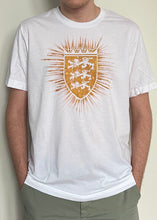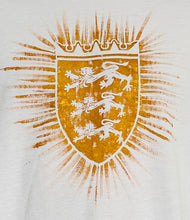The coat of arms of England is actually that of house Plantagenet, the ruling family of England during the high middle ages. Though originally from Anjou, France, they attained the English throne in 1154 upon the coronation of Henry II. They were the ruling family until 1485 when Richard III died in the Battle of Bosworth Field, and the throne passed to Henry VII.
The first evidence of humans in Britain is dated from between 800,000 and a million years ago. However, since very few finds have been made, the very early history of the country is virtually unknown. In the 4th millennium BCE, Neolithic immigrants from western and northwestern brought agriculture over to Great Britain. From here, they passed into the Bronze and then Iron age, where evidence of larger forts was found. It was during this period that Britain developed the Celtic culture. In the year 55 or 54 BCE, Julius Caesar launched an invasion of Britain during which accounts of the situation in Britain were recorded. From these accounts, we learned of the Catuvellauni, who controlled the region north of the Thames river, and the kingdom of Atrebates, which controlled the region south of the river. Britain remained fairly independent of the Roman Empire until 43 CE when the emperor Claudius decided to launch a conquest and sent the Roman army across the English Channel. Thus was born the Roman province of Britannia. The invasion gradually encompassed more of Britain, and the Roman culture, economy, and religion began to make headway. Roman rule eventually began slacking due to several reasons. Among them was the fact that the Roman capital was far abroad. During the civil war of Magnentius (350–351), many troops had to be withdrawn to fight, leaving the country open to rebellions. Further trouble appeared in 367 when organized seaborne attacks from the Irish Scots and Scottish Picts ravaged the shores. Over the following decades, more troops were withdrawn (by Magnus Maximus in 383; by Stilicho a few years later; and finally by Constantine III in 407, who used them in Gaul), further weakening the country. After suffering yet more attacks from the Pictish and Saxon peoples, they asked the emperor Honorius for troops in 1410. He, however, was unable to send more and told the cities to defend themselves. This is widely regarded as the end of Roman Rule.
Over the following centuries, peoples of various tribes and cultures, such as the Saxons, Jutes, Frisians, and Picts, settled in the country and began forming a new culture. At this time, Britain was a Heptarchy (from around the end of the 5th century to the latter half of the 9th). It was split into 7 distinct kingdoms. These were Northumbria, Mercia, East Anglia, Essex, Kent, Sussex, and Wessex. Though generally split into several independent kingdoms, a few notable rulers (such as Aelle of Sussex, Ceawlin of Wessex, and Aethelberht of Kent) became “bretwaldas” or rulers of multiple (if not all) separate kingdoms. Another great unifying force was the catholic church, who, through missionaries such as Augustine, managed to convert many of the natives. During the same period, Northumbria became the epicenter of scholarship. Foremost of these scholars was Bede (c. 672–735), a renowned theologian, historian, and monk. It was during this period that the epic Beowulf is thought to have been written. Over the following centuries, frequent Scandinavian invasions occurred in varying amounts of success. However, this period of disunity began to crumble during the reign of Edward the Elder. Edward launched large-scale invasions into Danelaw (territory controlled by the Danish within England) and conquered much of Great Britain. This quest for unity was finally completed during the reign of Edward’s son Aethelstan. He became the Rex totius Britanniae (King of all Britain) in 927. The rule of the west Saxon kings was fairly short-lived, as, after decades of Danish invasions, Sweyn Forkbeard was crowned king of England. The kingship eventually passed to Harold II Godwinson, who was to become the last Anglo-Saxon king of England, on January 6th, 1066. Just 9 months later, the Normans launched their invasion. On October 14th, 1066, Harold was shot dead in the eye with an arrow at the Battle of Hastings. William of Normandy, now William the Conqueror, was crowned king of England on Christmas day 1066. Thus begins the period of the High Middle Ages and medieval feudalism in Britain. The king would grant land to nobles, who in turn would grant their vassals parcels of their own land. The lowly serfs would then live off this land and provide food and service to their masters as payment.
The Norman French language and the Anglo-Saxon language slowly merged during this period to form English as we know it. In the 11th century and 12th century, respectively, Scotland and Ireland were conquered by the English throne. A major change in government came in 1215 when King John II wrote the Magna Carta and set down the basic rights guaranteed to people. Further revolutionary changes came during the reign of Edward I (1272–1307), who convened the first parliament. Queen Elizabeth I (1558–1603) was responsible for greatly strengthening the Royal Navy and entering a period of Imperialism during which they defeated the previously invincible Spanish Armada. In 1642, following renewed tensions between the house of commons and King Charles I, the English Civil War broke out. Charles was eventually executed, and Oliver Cromwell reigned. This rightful king, Charles II, was restored to the throne in 1660. In 1707, under mutual agreement, Scotland and England signed the Act of Union combining the two nations under the kingdom of Great Britain. The kingdom was further expanded in 1801 when the United Kingdom of Great Britain and Ireland was formed. It was during this same period when the Industrial Revolution began. Mechanization rapidly changed society as production and population both boomed. As Britain was the first to modernize, it became one of the most powerful countries in the world.




